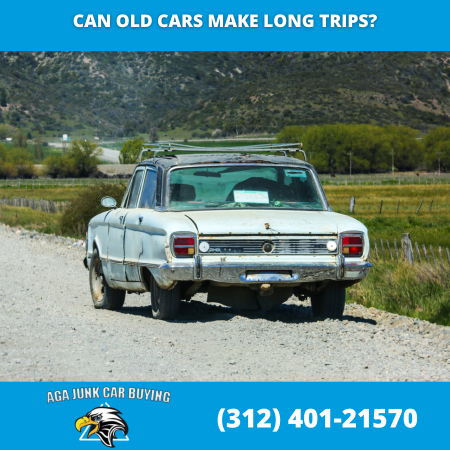Have you ever wondered if older cars are capable of long trips?
It’s a common question among car owners who may be hesitant to take their older vehicles on long trips.
While older cars may have some limitations compared to newer models, they can still be reliable companions on long trips with proper preparation and maintenance.
In this article, we will discuss what needs to be done before setting off on a long-distance journey with an older vehicle.
What are the challenges of taking an old car on a long road trip?
 Taking an older car on a long road trip can pose certain challenges.
Taking an older car on a long road trip can pose certain challenges.
Here are some of the most common ones:
-
Reliability:
Older cars can have more wear and tear, making them less reliable than newer models.
Mechanical problems and breakdowns are more likely to occur, especially if the car has not been well maintained or serviced regularly.
-
Lack of modern features:
Older cars may lack modern safety features and technology, such as advanced braking systems, stability control or connectivity options.
This can affect both safety and comfort during a long trip.
-
Fuel efficiency:
Older cars tend to have lower fuel efficiency compared to newer models.
This means you will have to make more frequent stops to refuel, which can add time and cost to your trip.
-
Comfort and amenities:
Older cars often have less comfortable seats, little legroom and an outdated interior.
This can make long journeys less enjoyable, especially if you are traveling for extended periods.
-
Safety considerations:
Older cars may lack modern safety features such as anti-lock brakes, airbags or stability control systems.
It is important to be aware of these limitations and take extra precautions to ensure a safe ride.
How do you prepare your old car for a long road trip?
Taking an old car on a long road trip requires some preparation and care, so let’s look at what needs to be done to get your vehicle ready.
1. Schedule a maintenance check:
Take your car to a trusted mechanic for a thorough inspection. They can identify any potential issues and address necessary repairs or maintenance tasks.
This may include checking the engine, brakes, tires, fluids, belts, hoses, and electrical systems.
2. Inspect tires:
Inspect the condition of the tires, including tread depth and sidewall integrity. Make sure all tires are properly inflated to the recommended pressure.
Consider replacing worn tires or tires that are nearing their useful life to ensure optimum traction and safety during the trip.
3. Test brakes:
Make sure you have adequate braking power by having your brakes checked by a professional mechanic.
Be aware of warning signs such as grinding noises or vibrations when braking, which can indicate worn brake components that need replacing.
4. Test the battery:
Check the battery’s condition and voltage to ensure it is in good shape. Clean any corrosion from the battery terminals and ensure a secure connection.
If the battery is weak or nearing the end of its life, consider replacing it to avoid potential starting issues during the trip.
5. Change fluids and filters:
Make sure all essential fluids, such as engine oil, transmission fluid, coolant and brake fluid, are clean and at recommended levels.
Replace filters that need to be changed, such as the oil filter and air filter.
6. Pack emergency supplies:
Prepare an emergency kit with essential items such as spare tire, jack, jumper cables, flashlight, basic tools, first aid kit, road flares and extra fluids.
Also, have a fully charged phone, a physical map and a list of emergency contacts on hand.
7. Check that lights and electrical equipment are working:
Be sure to check that all lights, signals and other electrical equipment are functioning properly before setting off.
If any of these features need replacing or repairs, have them attended to before the trip.
By following these steps, you can ensure your old car is ready for a long road trip. With proper care and maintenance, your older vehicle can be a reliable companion on your journey.
How long can you drive your old car without stopping?
In general, older cars should not be driven for more than 8 hours at a time without taking breaks.
It is important to take regular breaks during the journey to rest and refuel, especially if you are traveling for extended periods of time.
Additionally, taking breaks gives your old car an opportunity to cool down, reducing the strain on the engine and other components.
If you have an old van and want to get rid of it, you can contact a junk car buyer and get cash on the spot for it.
Can your old car handle long trips without breaking down?
While any vehicle can experience mechanical problems, proper care and maintenance can help reduce the chances of breakdowns.
Having your car serviced before setting off on a long journey and following all the preparation steps listed above will give your old car the best chance of making it through the trip without any issues.
It is also important to be aware of any warning signs from your vehicle that may indicate an issue while driving, such as grinding noises or vibrations, and take immediate action if necessary.
But if your car is too old and often breaks down on the road, the best thing you can do is sell it for cash with AGA Cash Junk Cars Inc.!
We are the best junk car buyers in all of Illinois and we pay top dollar for any type of vehicle, regardless of its condition.
Call us (312) 401-2157 to get the most money for your junk car!
What are the signs that my old car may not be suitable for a long trip?
If you are considering taking an old car on a long trip, it is important to assess its condition and determine whether it is capable of making the journey.
Some signs that your car may not be suitable for a long road trip include:
- Low fuel efficiency or poor performance
- Excessive oil consumption or smoke from the exhaust.
- An abundance of rattles, knocks and vibrations when driving .
- Leaks from engine components or fluids
- Visible rust, corrosion or damage to bodywork
- Poorly functioning electrical features, such as lights or signals.
- High mileage suggests increased wear and potential for breakdowns.
- Outdated safety features may compromise protection during a long trip.
If any of these issues are present in your vehicle, it is best to have it serviced by a qualified mechanic before setting off, or consider other transportation options.
It is also important to be aware of any warning signs from your vehicle while driving and act accordingly if necessary.
In conclusion, taking an old car on a long road trip can be a rewarding experience but it requires proper preparation and care to ensure a successful journey.
Following the steps outlined above and being aware of the potential limitations can help you make the most out of your travels in an older vehicle.
